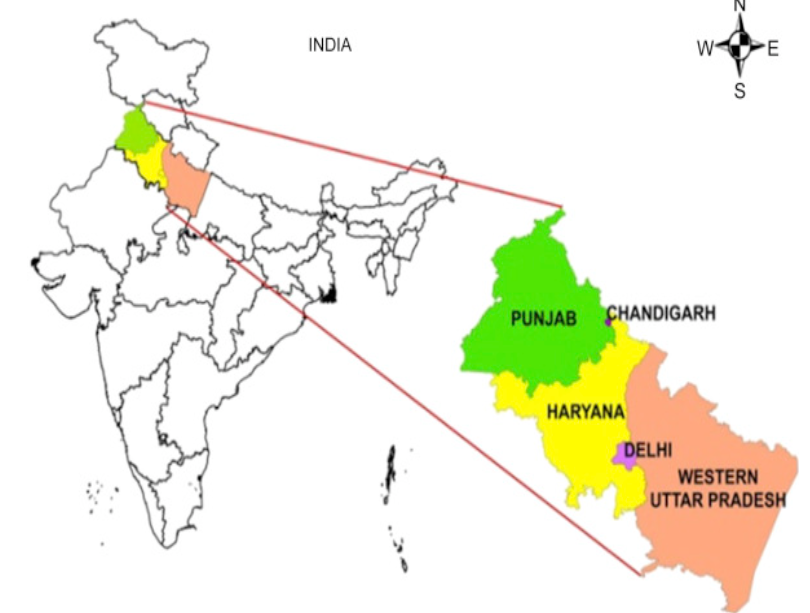Green revolution is a term coined by William Gourd in 1968 to describe a process that leads to improved agricultural productivity. Its has also been considered as the Third Agricultural Revolution in the world, after the First Agricultural Revolution, also known as the Neolithic Revolution, happened about 12,000 years ago and Second Agricultural Revolution, also known as the British Agricultural Revolution that saw an unmatched increase in agricultural production in Britain due to increased in labour and land productivity between the mid-17th and late 19th centuries.
In the present the world tends to be moving towards the Fourth Agricultural Revolution, similar to the fourth industrial revolution, encompasses the expected shifts driven by emerging technologies, notably the integration of AI for more informed decision-making and the empowerment of autonomous robots. These intelligent machines have the potential to revolutionize tasks like cultivation, harvesting, weeding, animal husbandry, and the precise distribution of agrochemicals using drones. Additionally, advancements in farming technology encompass novel forms of gene editing to cultivate crops with greater yields and resilience to diseases, vertical farming methods.
What is Green Revolution?
The Green Revolution denotes the adoption of high-yielding varieties (HYVs) of wheat and rice, primarily during the 1960s, aimed at amplifying food crop output, particularly in India. These newfound seed varieties, often referred to as ‘miracle’ seeds, originated from Mexico (wheat) (Locations of Norman Borlaug’s research stations in the Yaqui Valley and Chapingo) and the Philippines (rice). However, it was the innovative dwarf varieties of wheat that significantly boosted yields per hectare.

Objectives of Green Revolution in India
The varied objectives of Green revolution have been mentioned below:
Short Term
The revolution was launched to address India’s hunger crisis during the second Five Year Plan.
Long Term
Its long-term objectives included comprehensive modernization of agriculture through rural and industrial development, along with improvements in infrastructure and access to raw materials.
Globalisation of the Agricultural World
Through the dissemination of technology to non-industrialized nations and the establishment of numerous corporations in key agricultural regions.
Employment Generation
This expansion in industry, in turn, bolstered rural employment while concurrently boosting the industrial workforce.
Basic Elements of the Green Revolution
- Expansion of Agricultural Areas: Despite efforts to increase cultivated land since 1947, it proved insufficient to meet the growing demand. The Green Revolution played a crucial role in the quantitative expansion of farmlands.
- Introduction of Double-cropping System: A cornerstone of the Green Revolution was the adoption of a double-cropping system, which meant having two crop seasons annually instead of just one.
- The previous one-season-per-year practice was based on the fact that there is only one rainy season each year. The introduction of the second phase relied on extensive irrigation projects, involving the construction of dams and implementation of other straightforward irrigation methods.
- Utilizing Improved Genetic Seeds: A scientific facet of the Green Revolution was the utilization of seeds with enhanced genetic traits. The Indian Council for Agricultural Research developed new strains of high-yield variety seeds, primarily focusing on wheat, rice, millet, and corn.
- Significant Crops in the Revolution: The key crops included Wheat, Rice, Jowar, Bajra, and Maize. Non-food grains were excluded from the scope of the new strategy. Wheat remained the cornerstone of the Green Revolution for an extended period.
History of Green Revolution
The expression “Green Revolution” was initially coined by William S. Gaud, who served as the administrator of the U.S. Agency for International Development (USAID), during a speech on March 8, 1968.
Mexican Agriculture Revolution
Mexico has been referred to both as the ‘birthplace’ and the ‘cradle’ of the Green Revolution. The country not only received the knowledge and technology behind this revolution but also actively participated, receiving financial support from the government for agricultural initiatives led by Mexican agronomists. Prior to this transformation, agriculture in Mexico had been a significant sociopolitical concern, and the push for agricultural advancement ultimately led Mexico to achieve self-sufficiency in food production, with notable geopolitical implications during the Cold War.
Philippines and IR8 Rice
The introduction of IR8 variety of Rice, although dependent on fertilizers and pesticides, resulted in significantly higher yields compared to traditional cultivars. In the Philippines, annual rice production surged from 3.7 to 7.7 million tons over the span of two decades.
Agricultural Revolution in India
In 1961, as India was on the edge of a potential mass famine, Norman Borlaug received an invitation from Dr. M. S. Swaminathan, the advisor to the Indian Minister of Agriculture. Despite encountering bureaucratic obstacles set forth by India’s grain monopolies, the Ford Foundation and the Indian government joined forces to bring in wheat seeds from the International Maize and Wheat Improvement Center (CIMMYT).
The state of Punjab was chosen by the Indian government as the initial testing ground for these new crops, owing to its dependable water supply, the presence of fertile Indus plains, and a track record of agricultural success other states were been the part of it as Haryana, Western Uttar Pradesh and in some parts of Delhi and Chandigarh. India initiated its own Green Revolution initiative, encompassing plant breeding, the development of irrigation systems, and the provision of financial support for agrochemicals.

India swiftly embraced IR8, a semi-dwarf rice variety engineered by the International Rice Research Institute (IRRI), which demonstrated the ability to generate a higher grain yield per plant when cultivated with specific fertilizers and irrigation methods. In 1968, Indian agronomist S.K. De Datta published his research, revealing that IR8 rice could yield approximately 5 tons per hectare without any fertilizer and nearly 10 tons per hectare under optimal conditions.
This represented a tenfold increase in yield compared to traditional rice varieties. IR8 achieved remarkable success across Asia, earning it the moniker of “Miracle Rice.” Furthermore, IR8 was further developed into the semi-dwarf variety known as IR36.
Green Revolution in India
The Green Revolution, launched in the 1960s by Norman Borlaug, earned him the title of the ‘Father of Green Revolution’ worldwide. This monumental effort resulted in his receiving the Nobel Peace Prize in 1970 for his contributions to the development of High Yielding Varieties (HYVs) of wheat.
In India, M.S. Swaminathan played a pivotal role in spearheading the Green Revolution. This transformative movement brought about a substantial surge in the production of food grains, particularly wheat and rice, by introducing new, high-yielding variety seeds to developing nations, commencing in the mid-20th century.
Spanning from 1967-68 to 1977-78, the Green Revolution not only altered India’s status from a food-deficient nation but also elevated it to the ranks of the world’s foremost agricultural powers.
Background of Green Revolution in India
In 1943, India faced the most severe recorded food crisis in history: the Bengal Famine. This tragic event resulted in the loss of approximately 4 million lives in eastern India due to starvation.
- Even after gaining independence in 1947, until 1967, the government primarily focused on expanding agricultural areas. However, the population was growing at a much faster pace than food production.
- The Green Revolution in India denotes a period when Indian agriculture underwent a transformation into an industrialized system through the adoption of modern techniques and technologies, including the use of High Yielding Variety (HYV) seeds, tractors, irrigation infrastructure, pesticides, and fertilizers.
- This agricultural revolution in India is predominantly characterized as the Wheat Revolution, given that wheat production increased by more than threefold between 1967-68 and 2003-04, whereas the overall increase in cereal production was only twofold.
Positive and Negative impacts of Green Revolution
| Positive Impacts | Negative Impacts |
| Increase in Crop Produce: The Green Revolution led to a remarkable grain output of 131 million tonnes in the year 1978-79, solidifying India’s position as one of the world’s leading agricultural producers. Additionally, the cultivation of high yielding varieties of wheat and rice saw a significant expansion during this period. | Non-Food Grains Left Out: While the Green Revolution brought significant gains to staple food-grains like wheat, rice, jowar, bajra, and maize, it did not extend its impact to other crops such as coarse cereals, pulses, and oilseeds. Additionally, major commercial crops like cotton, jute, tea, and sugarcane remained largely unaffected by the Green Revolution. |
| Reduced Import of Food-Grains: India achieved self-sufficiency in food-grains and maintained ample reserves in the central pool. In fact, there were occasions when India could even export food-grains. Additionally, there has been an increase in per capita net availability of food-grains. | Limited Coverage of HYVP: The High Yielding Variety Programme (HYVP) focused exclusively on five crops: Wheat, Rice, Jowar, Bajra, and Maize. As a result, non-food grains were not included in this new strategy. This was due to the fact that either HYV seeds for non-food crops had not yet been developed, or they were not deemed suitable for farmers to take the risk of adopting. |
| Benefits to the Farmers: The advent of the Green Revolution elevated farmers’ income levels. They reinvested their surplus earnings to enhance agricultural productivity. This revolution especially favored large-scale farmers with more than 10 hectares of land, as they could invest substantial amounts in inputs such as High Yielding Variety (HYV) seeds, fertilizers, machinery, and more. Additionally, it further encouraged capitalist farming. |
Regional Disparities: The Green Revolution technology has exacerbated economic disparities, both within and between regions. Currently, it has impacted only 40 percent of the total cultivated area, leaving 60 percent unaffected. The most pronounced effects are observed in Punjab, Haryana, and western Uttar Pradesh in the north, as well as Andhra Pradesh and Tamil Nadu in the south. Conversely, the Eastern region (encompassing Assam, Bihar, West Bengal, and Orissa) and the arid and semi-arid zones of Western and Southern India have seen minimal influence. Essentially, the Green Revolution has primarily benefited regions already endowed with favorable agricultural conditions. This has, in turn, intensified existing regional disparities, deepening the problem further. |
| Industrial Growth: The Revolution ushered in extensive farm mechanization, leading to a heightened demand for various machines such as tractors, harvesters, threshers, combines, diesel engines, electric motors, pumping sets, and more. Additionally, there was a substantial increase in the need for chemical fertilizers, pesticides, insecticides, and weedicides. Moreover, numerous agricultural products found applications as raw materials in various industries, giving rise to what are known as agro-based industries. |
Excessive Usage of Chemicals: The Green Revolution brought about extensive utilization of pesticides and synthetic nitrogen fertilizers to enhance irrigation schemes and crop varieties. Regrettably, there were minimal to no endeavors made to educate farmers about the substantial risks linked to the intensive application of pesticides. Typically, untrained farm laborers would spray pesticides on crops, often neglecting proper instructions and precautions. This practice ended up causing more harm than good to the crops and became a significant contributor to environmental and soil pollution. |
| Rural Employment: The implementation of multiple cropping and increased fertilizer usage led to a notable surge in the demand for labor. The Green Revolution not only generated ample employment opportunities for agricultural workers but also for industrial workers, as it spurred the development of related facilities like factories and hydroelectric power stations. | Water Consumption: The Green Revolution ushered in crops that were highly reliant on water. Primarily cereals, these crops accounted for nearly 50% of the dietary water footprint. To support these water-intensive crops like sugarcane and rice, canal systems were implemented, and irrigation pumps extracted groundwater, leading to a decline in groundwater levels. Due to its significant cultivation of wheat and rice, Punjab stands as one of the most water-depleted regions in India. |
| Impacts on Soil and Crop Production: Intensive cropping cycles aimed at boosting production led to the depletion of soil nutrients. In response to the demands of these new seed varieties, farmers escalated their use of fertilizers, causing an increase in soil pH levels due to the application of alkaline chemicals. The presence of toxic substances in the soil disrupted beneficial microorganisms, further contributing to declining yields. |
|
| Unemployment: With the exception of Punjab, and to some degree in Haryana, the mechanization of farming brought about by the Green Revolution resulted in widespread unemployment among agricultural laborers in rural areas. Those most adversely affected were the impoverished and landless laborers. | |
| Health Hazards: The extensive application of chemical fertilizers and pesticides such as Phosphamidon, Methomyl, Phorate, Triazophos, and Monocrotophos led to a range of severe health issues, including cancer, renal failure, stillbirths, and birth defects. |
Green Revolution Krishonnati Yojana
In 2005, the government of India launched the Green Revolution Krishonnati Yojana to bolster the agricultural sector. The scheme aims to comprehensively and scientifically develop the agriculture and allied sectors, ultimately leading to an increase in farmers’ income. It encompasses 11 schemes and missions under a unified umbrella scheme:
- Mission for Integrated Development of Horticulture (MIDH)
- National Food Security Mission (NFSM)
- National Mission for Sustainable Agriculture (NMSA)
- Submission on Agriculture Extension (SMAE)
- Sub-Mission on Seeds and Planting Material (SMSP)
- Sub-Mission on Agricultural Mechanization (SMAM)
- Sub-Mission on Plant Protection and Plan Quarantine (SMPPQ)
- Integrated Scheme on Agriculture Census, Economics, and Statistics (ISACES)
- Integrated Scheme on Agricultural Cooperation (ISAC)
- Integrated Scheme on Agricultural Marketing (ISAM)
- National e-Governance Plan in Agriculture (NeGP-A)
Green Revolution Conclusion
The Green Revolution rescued India from a major food crisis, establishing unprecedented food security. This success story enabled the country to attain self-sufficiency and even enter the global market as a food grain exporter.
However, there was oversight regarding the negative environmental impacts and the lack of knowledge among Indian farmers regarding the use of heavy-duty chemical fertilizers. This led to setbacks towards the end of the Green Revolution.
It’s imperative to recognize the benefits of indigenous crops and work towards their resurgence, as food security must also encompass the nutritional well-being of the nation.
Stakeholders should spearhead well-planned and collaborative research efforts to preserve traditional crop varieties and integrate them into the nation’s food and nutrition security strategies, given their substantial nutritional advantages. Special attention must be given to the impact on ecology and the water table.







